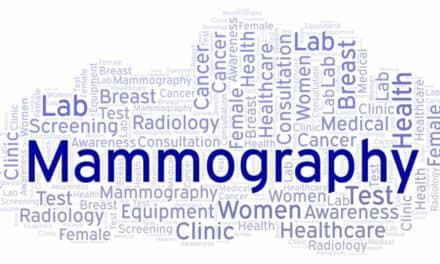Nashua, N.H.-based iCAD, Inc. announces the launch of ProFound AI Risk for digital breast tomosynthesis (DBT), or 3D mammography, as well as an updated version of PowerLookDensity Assessment. Both technologies offer improved accuracy and enhanced functionality compared to previous versions of the software, iCAD officials say.
ProFound AI Risk is a clinical decision support tool that provides a short-term breast cancer risk estimation for each woman, based only on a 2D or 3D mammogram, while PowerLook Density Assessment is an automated breast density assessment algorithm using synthetic images generated from 3D mammography.
“ProFound AI Risk and PowerLook Density Assessment have the potential to truly transform personalized breast cancer screening and risk stratification as we know it,” says Stacey Stevens, president of iCAD, inc. “We believe these technologies will lead to more appropriate utilization of supplemental imaging and biopsies, less anxiety for women, and decreased costs to the system overall. We believe these solutions will be increasingly relevant in the years ahead, as mammography begins to transition from what is primarily an age-based screening paradigm today to a more effective and efficient risk-adjusted screening paradigm.”
ProFound AI Risk
The latest version of ProFound AI Risk offers expanded features, including:
- The ability to calculate short-term (one-, two- or three-year) absolute risk based on either 2D or 3D mammography images.
- The ability to factor in clinically relevant global screening guidelines and more than 15 country incidence and mortality reference tables, including ethnicities, for alignment with that country’s general population.
“Factoring in a woman’s racial and ethnic background adds another dimension of personalization that allows clinicians to stratify risk in a more inclusive way,” adds Stevens. “Studies show African American women have an approximately 40% higher risk of dying from breast cancer, and they are disproportionately affected by more aggressive subtypes, such as triple-negative breast cancer and inflammatory breast cancer, compared to white women. The latest generation of ProFound AI Risk offers the potential to address these racial disparities and improve outcomes for women, including those who may have higher risks of developing cancers between screenings due to genetic predispositions.”
Moreover, ProFound AI Risk utilizes breast complexity findings, automated breast density, and age in order to calculate a woman’s short-term, absolute risk of breast cancer. Results include the woman’s absolute breast cancer risk score and breast cancer risk category (low, general, moderate, and high).
Regular, age-based mammography screening reduces breast cancer mortality by approximately 20%, but screening mammography can still miss 20%-40% of breast cancers. Many of these cancers are diagnosed as interval breast cancers, defined as those that emerge after a normal mammogram but before the woman’s next scheduled screening. These tumors are often diagnosed at a later stage than cancers detected by screening and are associated with an increased risk of breast cancer-specific mortality, compared with cancers detected by screening.
PowerLook Density Assessment
iCAD also launched the latest version of PowerLook® Density Assessment software on the new PowerLook 10 platform. This software identifies the patient’s anatomy, segments the breast, and then measures adipose and fibroglandular tissue and its dispersion to determine the density category in alignment with BI-RADS 5th Edition lexicon.
“Radiologist visual density assessment has suboptimal intra- and inter- observer agreement due to its visual, subjective assessment. This inconsistent reporting causes confusion, impacts patient care and derails referring physician and patient confidence,” says Randy Hicks, MD, co-owner and CEO of Regional Medical Imaging in Michigan.
“With PowerLook Density Assessment software, clinicians can feel confident in their patients’ density assessment,” Hicks adds. “This solution is easy to integrate and implement, and it’s the ideal choice for those seeking to accurately automate density assessment and harmonize the patient experience.”






